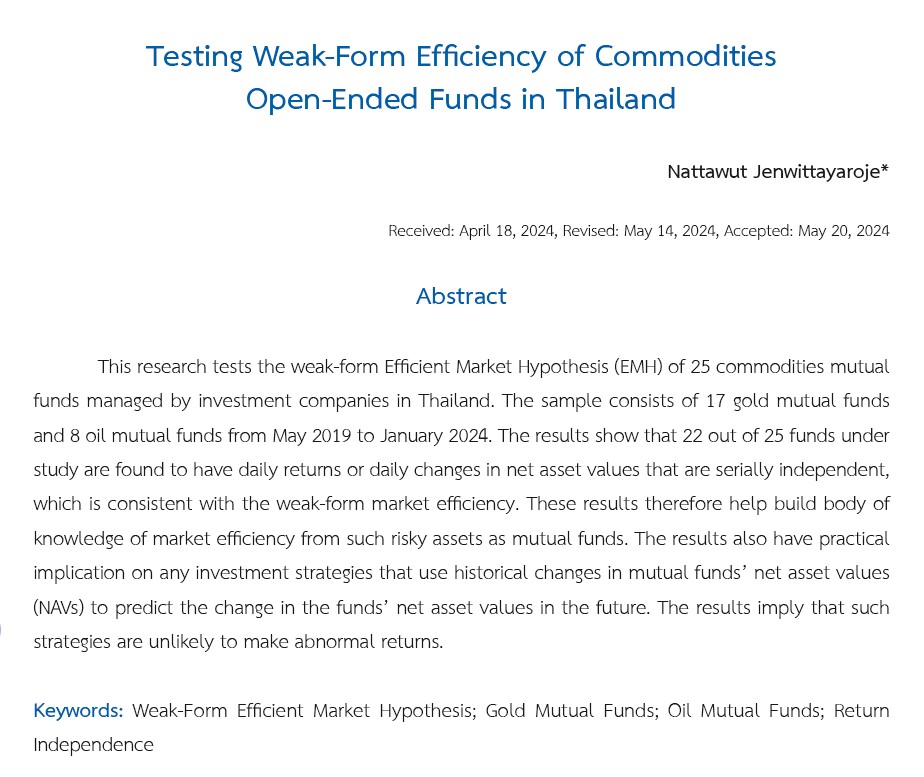Testing weak-form efficiency of commodities open-ended funds in Thailand
Keywords:
Weak-form Efficient Market Hypothesis , Gold Mutual Funds, Oil Mutual Funds, Return IndependenceAbstract
This research tests the weak-form Efficient Market Hypothesis (EMH) of 25 commodities mutual funds managed by investment companies in Thailand. The sample consists of 17 gold mutual funds and 8 oil mutual funds from May 2019 to January 2024. The results show that 22 out of 25 funds under study are found to have daily returns or daily changes in net asset values that are serially independent, which is consistent with the weak-form market efficiency. These results therefore help build body of knowledge of market efficiency from such risky assets as mutual funds. The results also have practical implication on any investment strategies that use historical changes in mutual funds’ net asset values (NAVs) to predict the change in the funds’ net asset values in the future. The results imply that such strategies are unlikely to make abnormal returns.
References
Aumebooksuke, V. (2012). Weak form efficiency of six equity exchanges in ASEAN. European Journal of Scientific Research, 84(4), 532–538.
Aumebooksuke, V., & A. L. Dryver. (2014). The importance of using a test of weak-form market efficiency that does not require investigating the data first. International Review of Economics and Finance, 33, 350–357. https://doi.org/10.1016/j.iref.2014.02.009
Fama, E. F. (1965). The behavior of stock market prices. Journal of Business, 38(1), 34-105. https://doi.org/10.1086/294743
Fama, E. F. (1970). Efficient capital markets: A review of theory and empirical work. Journal of Finance, 25(2), 383-417. https://doi.org/10.2307/2325486
Jenwittayaroje, N. (2021). Testing weak-form market efficiency in the Stock Exchange of Thailand. Global Business and Economic Review, 24(3), 211–224. https://doi.org/10.1504/GBER.2021.114657
Jenwittayaroje, N. (2022). The study of the return behavior of the big-cap stocks on the Stock Exchange of Thailand: evidence from pre, during, and post-Covid-19. NIDA Business Journal, 31, 96–112.
Kenourgios, D., & Y. Samios. (2021). Halloween effect and active fund management. The Quarterly Review of Economics and Finance, 80, 534-544. https://doi.org/10.1016/j.qref.2021.04.006
Khanthavit, A., Boonyaprapatsara, N., & Saechung, A. (2012). Evolving Market Efficiency of Thailand’s Stock Market. Applied Economics Journal, 19(1), 46-67.
Nargunam, R., & N. Anuradha. (2017). Market efficiency of gold exchange-traded funds in India. Financial Innovation 3, Article number 14. https://doi.org/10.1186/s40854-017-0064-y

Downloads
Published
How to Cite
Issue
Section
License
Copyright (c) 2024 NIDA Business School, National Institute of Development Administration

This work is licensed under a Creative Commons Attribution-NonCommercial-NoDerivatives 4.0 International License.



